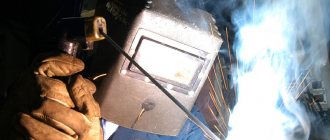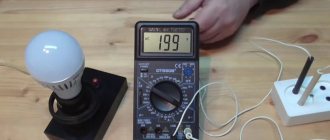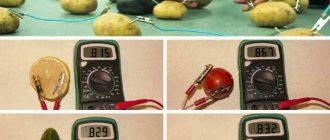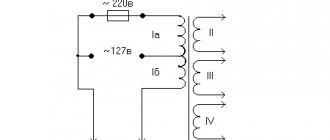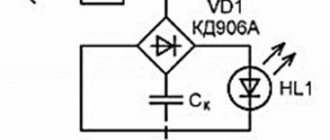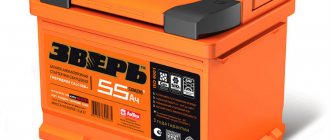The most unpleasant thing that can happen to the automatic protective circuit of an electrical circuit is that it will not work at the right time. To prevent this from happening, all devices are subject to repeated testing, and this is done not only during manufacture, but also during operation - this can also be done at home. At the same time, if everyone is already accustomed to protective circuit breakers and the principle of their operation, then how to check the RCD - how ready it is for an emergency situation to arise - often remains a mystery for a user inexperienced in electrical engineering.
The principle of checking the performance of an RCD
When a material is tested for strength, they try to break it. To test circuit breakers, it is necessary to create conditions under which they will work - all existing tests are carried out according to these rules.
The residual current device trips if it detects a current leak, i.e. when more current is supplied to an electrical circuit through the phase wire than comes out of it through the neutral wire. Connecting an RCD can be done in houses with or without grounding - to carry out checks, you need to understand the difference between these methods of protecting household appliances and people.
- In the first case, if the wiring insulation is broken, then part of the current goes to the body of the electrical appliance, from where it immediately goes to the ground wire, as a result of which a leak occurs, which the residual current device immediately registers and opens the circuit.
- If there is no grounding, then if the insulation is damaged, the current again enters the body of the electrical device, but since it has nowhere else to go, then in general the balance between the input and output is maintained and the RCD does not yet trip. A leak will be detected only if a person touches a faulty electrical appliance - current will flow through the body, the balance between the incoming and outgoing current in the main circuit will be disrupted and the RCD will immediately turn off the power.
Those. a correctly connected and working residual current device will work in any case, but if the network is without grounding, then the fault will be detected only after the person is slightly tickled with electric current (if the device is correctly selected, then even painful sensations should not occur).
Of course, if there is no grounding, then checking the functionality of the RCD by touching the phase wire is, to put it mildly, a very extreme method - if suddenly the device is faulty, then a noticeable electric shock is inevitable.
Despite the difference in connection methods, the operating principle of the residual current device remains unchanged and all methods for testing the device are suitable in both cases. In this case, the installed automatic circuit breaker is checked in exactly the same way, because it is the same RCD, only combined in one housing with a circuit breaker.
How does an RCD work?
The main functional block of the RCD is the differential transformer. It compares the current strength in the phase and neutral conductors. In normal mode, when there is no current leakage to the ground, the currents in the phase and neutral working conductors (wires) are equal in value, but opposite in sign (in direction). In a differential transformer in normal mode, both primary windings create exactly the same, oppositely directed magnetic fields. Which in the core of a differential transformer, when summed up, give a zero result. Therefore, the current in the secondary winding is zero.
When the insulation breaks down or a person touches one live part (which is energized), a ground fault current (grounding) appears. The current strengths in the phase and neutral conductors become different. Accordingly, the magnetic fluxes in the differential transformer cease to be equal, that is, their sum becomes different from zero. As a result, a so-called unbalance current appears in the secondary winding (also known as differential current - hence the name of the transformer). This same current affects the tripping mechanism of the RCD, and the circuit protected by the RCD is switched off.
Test button – built-in leakage current simulator
On the front panel of each residual current device there is a button with the letter “T” or the inscription “Test”. This is the easiest way to quickly check an RCD - when you press this button, an additional capacitance or resistance appears in the electrical circuit, where part of the current goes. A leakage current occurs, which will trigger the residual current device.
Despite the obvious usefulness of this function, you need to understand that the “Test” button on the RCD itself is not a panacea and its operation or failure to operate does not provide complete information about the state of the device. The options here could be the following:
- If the RCD does not trip, but it is only connected, then in addition to a malfunction, this may indicate improper installation of the device itself. In this case, first of all you need to double-check the connection diagram.
- If the button worked before, but now it doesn’t, then a more thorough check of the RCD and its connection diagram is necessary.
- The “Test” button itself does not work, but the residual current device is generally working. This can only be checked using additional methods, but in any case, the device is defective and it is strongly recommended to replace it.
- Additional check methods confirm that the device itself is faulty - there is no option to replace the device.
The RCD check with the “Test” button should be carried out regularly - about once a month, and with more in-depth methods at least once a year.
Verification methods from simple to complex
There are several ways to check the quality of RCD operation. Ranking them by degree of complexity, we get the following set of possibilities:
- testing using a battery or magnet (only for electromechanical RCDs);
- testing using the “T” or “Test” button, if available;
- checking with a test lamp;
- using a rheostat;
- checking with a special device.
The very first ones on the list require little or no equipment, and therefore are accessible to anyone. The last two testing methods are used by electricians in production or employees of electrical laboratories.
Testing with a battery
Testing the RCD with a battery is one of the safest testing methods - here you do not have to wait until a leakage current appears, but conditions are created under which the RCD “thinks” that it has arisen. In addition, the current generated by the battery is not felt in any way by a person.
The point is to pass current only through one of the device’s coils - there will be no current on the second and the internal “calculator” of the device will give a command to open the circuit. By the way, in this way you can easily check the performance of the RCD when purchasing.
In practice it looks like this:
- If the residual current device is already connected to the network, then it is first disconnected from all wires.
- Short wires are connected to one of the poles of the device (left or right terminals at the top and bottom) (so that you can touch the battery with them).
- The ends of the wires (stripped of insulation) touch the plus and minus of the battery - current will flow through one of the coils of the device and if the RCD is working properly, the protection will work.
The following video demonstrates the use of this method:
When performing such a check, three main points must be taken into account:
- The current supplied by the battery must be at least equal to, or better yet exceed, the current setting of the device - if the latter is 100 mA, and the battery produces 50, then operation will not occur.
- It is likely that you will have to observe the polarity - if after touching the battery terminals the battery does not operate, then you need to swap the plus and minus positions. If operation does not occur again, then this is already a malfunction indicator or a purchased electronic residual current device.
More details about the difference in checking electronic and electromechanical RCDs in the video:
Characteristics of the protective device
You can find many different models of residual current switches on sale. They differ from each other in production standards, installation method and area of use.
The wrong choice of protection device can lead to the following troubles:
- The device will constantly operate in response to the slightest leaks that are present in the electrical network of each home.
- If a device with overrated characteristics was selected during purchase, it may not respond to an emergency situation. As a result, there is a high risk of electrical injury.
To avoid such incidents, it is imperative to study the characteristics of the RCD. You can read them by special markings on the body of the device.
Rated load current
This is one of the most important characteristics. The number indicates the maximum current value that can pass through the device for a long time without causing any harm to it. The magnitude is determined by the immunity of power contacts and conductors of a certain load. However, they remain in working order.
The rated current value is always indicated on the front panel of the protective device. It’s easy to find the optimal value for yourself by knowing the maximum power consumption. It must be divided by the phase voltage. It makes no sense to install an RCD with a current greater than the rated current of the machine in front of it.
Rated current values are typical for all models: 16 A, 25 A, 40 A, 63 A, 80 A, 100 A, 125 A.
What is trip current?
We can say that this is the most important parameter. It indicates the leakage current at which the protection is triggered and the device is turned off. On the body this value is indicated by the symbols IΔn. Standard residual current rating settings range from 6 mA to 500 mA.
Each of the values indicates exactly where the device can be used. For example, a device with IΔn equal to 500 mA will not be able to protect a person from electrical injury.
Non-breaking rated residual current
This is a parameter characterizing the response threshold of the device. It is designated as IΔn0. The value is always equal to half of the rated differential current (IΔn), that is, a device with a value of 10 mA will be switched off during a current leak of 5 mA.
If a leakage current flows through the protective device less than this indicator, the device will not operate.
RCD response time
This value shows the reaction speed of the protective device in an emergency situation. The nominal tripping time of the RCD is indicated by the symbols Tn. The norm is a maximum of 0.3 seconds. High-quality modern protection devices operate in 0.1 seconds, but such a high speed is not in demand.
Types of devices: AC - the device is triggered when an alternating current occurs instantly; A – with alternating or pulsating current; B – at constant, rectified and alternating; S – a certain time is maintained before triggering (0.15-0.5 sec); G – exposure time is less than the previous one (0.06-0.08 sec).
Checking the operation of the RCD with a control lamp
In this case, current leakage is directly created from the circuit, which is protected by the RCD. To carry out the check correctly, you need to understand whether there is a ground in the circuit or whether the residual current device is connected without it.
To assemble the control you will need the light bulb itself, a socket for it and two wires. In essence, a carrying lamp is assembled, but instead of a plug there are exposed wires that can be used to touch the contacts being tested.
Nuances of assembling the control
When assembling the control, two important nuances must be taken into account:
- Firstly, the lamp must be powerful enough to create the required leakage current. If a standard RCD with a setting of 30 mA is tested, then there are no problems - even a 10 Watt light bulb will take a current of at least 45 mA from the network (calculated by the formula I=P/U => 10/220=0.045).
Attention should be paid to this point in the case when the setting of the residual current device is about 100 mA - then you need to take a light bulb with a power of at least 25 Watts.
- Secondly, if you take a light bulb that is too powerful. If the only question is how to check the RCD for operation, then you can ignore this point. If you additionally need to evaluate whether the setpoint value has been miscalibrated, then you will have to supplement the diagram. For example, if you assemble a control with a 100-watt light bulb, then the current on it will be about 450 mA. At the same time, it is unknown at what current the protective shutdown device was triggered - if it is nevertheless miscalibrated and triggers instead of 30 at a current of 100 mA, then a person can receive a fatal electric shock. To check the RCD for operation at the rated current, you need to add a resistance to the test, which will reduce the current in the circuit to the required level.
Important!!! In this case, the resistance of the light bulb itself must be calculated, and not measured with a multimeter, since the resistance of a cold tungsten filament is approximately 10-12 times less than that of a hot one.
Calculation of control resistance
Ohm's law will help you calculate the required resistance - R=U/I. If you take a 100 Watt light bulb to test a residual current device with a setting of 30 mA, then the calculation procedure is as follows:
- The voltage in the network is measured (for calculations a nominal value of 220 Volts is taken, but in practice plus or minus 10 volts can play a role).
- The total resistance of the circuit at a voltage of 220 Volts and a current of 30 mA will be 220/0.03≈7333 Ohm.
- With a power of 100 watts, the light bulb (on a 220 volt network) will have a current of 450 mA, which means its resistance is 220/0.45≈488 ohms.
- To obtain a leakage current of exactly 30 mA, a resistor with a resistance of 7333-488≈6845 Ohms must be connected in series to the light bulb.
If you take light bulbs of a different power, then you will need different resistors. It is also necessary to take into account the power for which the resistance is designed - if the light bulb is 100 watts, then the resistor must be corresponding - either 1 with a power of 100 watts, or 2 of 50 (but in the second option, the resistors are connected in parallel and their total resistance is calculated using the formula Rtotal = (R1*R2)/(R1+R2)).
To guarantee, after assembling the control, you can connect it to the network through an ammeter and make sure that the required current flows through the circuit with the light bulb and resistor.
Testing an RCD in a grounded network
If the wiring is laid according to all the rules - using grounding, then here you can check each outlet separately. To do this, the voltage indicator determines which terminal of the socket the phase is connected to, and one of the test probes is inserted into it. The second probe must touch the grounding contact and the protective shutdown device should operate, since the current from the phase went to grounding and did not return through zero.
If suddenly the RCD does not work, then we must remember that this is not necessarily the fault of the device - the grounding line may also be faulty.
In this case, additional checks are required and if grounding testing is a separate topic, then checking the RCD can be performed directly in the following way.
Testing an RCD in a single-phase network without grounding
To a correctly connected residual current device, the wires from the distribution panel come to the upper terminals, and to the protected devices they leave from the lower ones.
In order for the device to decide that a leak has occurred, you need to touch the lower terminal with one control probe, from which the phase leaves the RCD, and with the other probe touch the upper zero terminal (to which zero comes from the distribution panel). In this case, by analogy with a battery test, the current will flow through only one winding and the RCD must decide that a leak is occurring and open the contacts. If this does not happen, then the device is faulty.
Reasons for device operation
There are a lot of reasons for a network shutdown by a protection device, but only after identifying them can the problem be completely eliminated.
Moreover, you need to try to find the problem area as soon as possible in order to avoid serious consequences.
Reason #1 - current leakage
Network leaks most often occur when there is old electrical wiring. Over time, the insulation dries out and some areas become exposed. The same problem can arise after replacing the old wiring with a new one, when the connection was made poorly.
Before hammering a nail into the wall to hang a picture or lamp, be sure to find out the location of the hidden electrical wiring.
The third, quite common reason is accidental damage to hidden wiring. For example, driving a nail into a wall.
Reason #2 - short circuit between ground and zero
The PUE rules prohibit combining neutral conductors and grounding. However, some careless craftsmen reject the existing “taboos” and do everything their own way, despite the fact that in this way the threat of electrocution to people increases many times over.
Reason #3 - unfavorable weather conditions
Weather can significantly affect the performance of the protective device when the distribution panel is located outside the premises, that is, on the street. Due to the appearance of tiny water particles inside the structure, the device may trigger.
If it is frosty outside, the protection device, on the contrary, may not perform its functions. This is due to the fact that low temperatures negatively affect microcircuits and can completely damage them.
There are known cases of network shutdown by a protective device during a thunderstorm. Lightning can aggravate even very minor leaks present in a home.
Reason #4 - incorrect installation of the device itself
An incident such as a false shutdown can occur periodically due to improper installation of the protective device.
Therefore, it is advisable to carry out installation yourself only after thoroughly studying the instructions. This also includes incorrect selection of characteristics when purchasing.
Reason #5 - problems with household electrical appliances
Failure of the cord with which a household electrical appliance is connected to the network causes an instantaneous operation of the protective device.
This also happens when current leaks from internal spare parts, for example, the heating element of a water heater or the motor winding of any of the switched-on devices.
Reason #6 - high humidity
It happens that after installing hidden wiring, the route is covered with putty and they immediately try to check the work done. In such cases, the protective device is triggered due to the wet putty surrounding the wires.
This is due to the ability of water to provoke leakage through microscopic cracks and other insulation defects. If you wait until the putty material has completely dried and repeat the manipulation, most likely the shutdown will not happen again.
Checking the leakage current at which the RCD is triggered
Here the same control lamp with a resistor is used, but in addition an ammeter and another variable resistance are connected to them in the circuit. The latter is often used as a dimmer - a light switch with brightness adjustment.
The verification procedure is as follows:
- The rheostat (dimmer) is set to maximum resistance and the entire circuit is connected as when checking a residual current device in a network without grounding - one probe to the phase output “from the RCD”, and the other to the zero input “to the RCD”.
- Next, slowly reducing the resistance of the rheostat, you need to observe the readings of the Ammeter - at what current strength the operation will occur, this is what the RCD is designed for.
If the RCD setting is about 30 mA, there is nothing to worry about if the operation occurs at a lower current strength - 10-25 mA - this is a kind of reserve in case of a sharp increase in the leakage current, so that the residual current device has time to be guaranteed to operate and a person, even in extreme cases, does not “get » more than 30 mA.
You can clearly see the methods of checking RCDs in the following video:
Method number 2 - With a battery
The second and no less simple method of testing an RCD for operation is using a regular AA battery. In this case, even an electric kettle can check its functionality. In addition, it will be possible to determine whether the residual current device is working properly in the store when purchasing the RCD.
So, you can independently check the operation of the product as follows:
- Connect a wire at least 10 cm long to one of the poles of the protective automation.
- Place the AA battery close to two wires: you connected the first one, and the second one, as a rule, is installed underneath at the factory.
When the wires touch plus and minus, the RCD should be triggered. If the lever does not operate, turn the battery over and test again. If the residual current device is working properly, the lever should be knocked out, which will indicate the functionality of the automation. You can see in more detail how to check the operation of a protection device using a battery in this video example:
Method for checking operation using a battery
Sequence and order of testing (measurements).
8.1. Assemble the test circuit as shown in Fig. 1
Fig.1. Measurement of equipment equipped with an RCD using a pointed probe or a plug-type probe (neutral wire may not be connected).
8.2 Measuring the response time of the RCD.
To measure the response time of the RCD and active grounding resistance, you must:
— connect L, N (neutral wire may not be connected) and PE electrical equipment in accordance with Fig. 6;
— using the switch, select the measurement function RE, tA and the specified multiple of the rated differential current;
— using key 11, select a selective or conventional RCD switch;
— using key 10, select the safe voltage value;
— using key 9, select the nominal value of the residual current switch;
— using key 8, select the type of test current and the initial phase (in the case of a sinusoidal type);
- when you press key 6, RE is measured, the result is displayed on the main reading field 15
— when you press 6 again; t D is measured.
In the case of selective switches, after starting the measurement there will be a delay of 30 seconds, which is signaled in the main field.
After the RCD circuit breaker is turned off, the response time value will be displayed in the main field 15.
Using key 13, you can display the result of measuring the active grounding resistance RE. Pressing this key again will return to pin tA. While both measurement results are displayed, additional field 16 displays the rated current value set for this type of switch.
8.3 Measurement of contact voltage and inrush current of RCD.
– In order to measure the inrush current, it is necessary:
– connect L, N (the neutral wire does not need to be connected) and PE from the electrical equipment in accordance with Fig. 6;
– use the switch to select the measurement function UB, ID;
– using key 11, select a selective or conventional RCD switch;
– using key 10, select the safe voltage value;
– using key 9, select the rated value of the differential current of the switch being measured;
– using key 8, select the type of test current and the initial phase (in the case of a sinusoidal type);
– when pressing key 6; Uв is measured, the result is displayed on the main reading field 15
– when you press 6 again; ID measurement is performed. If the RCD switch is turned off, then the inrush current value will be displayed in the main field 15.
Pressing this key again will return to the I D pin.
While both measurement results are displayed, additional field 16 displays the rated current value set for this type of switch.
If we are only interested in measuring the contact voltage UB, before the next measurement we must press key 8, which will end the inrush current measurement step IA.
8.4 Automatic measurement of RCD operating parameters.
In order to measure all RCD starting times, as well as the starting current IA, contact voltage UB and active resistance RE, you can use the automatic measurement function.
There is no need to start the measurement every time, you only need to initiate the measurement and turn on the RCD after each trip.
For the set rated current value of the circuit breaker and the selected type of current, the device performs a series of measurements in the following sequence:
| No. | Measured parameters | Measurement conditions | |
| Sinusoidal current | Unidirectional ripple current | ||
| 1. | UB, RE | ||
| 2. | tA | 0.5IDn | 0.5IDn |
| 3. | tA | 0.5IDn | 0.5IDn |
| 4.* | tA | 1IDn | 1IDn |
| 5.* | tA | 1IDn | 1IDn |
| 6.* | tA | 5IDn | 5IDn |
| 7.* | tA | 5IDn | 5IDn |
| 8.* | I.A. | ||
| 9.* | I.A. |
* points in which, provided that the RCD switch is in working order, it should turn off.
If during the measurement process the RCD is triggered (switched off), the display will display the message 54 , informing you that it needs to be turned on.
After turning on the RCD, the measuring device will perform the following measurement. If the meter worked correctly, then after the series of changes is completed, the display shows the inscription 49.
If the switch operates at half the current I Dn or does not operate in other cases, the measurement process is interrupted and the message 50 appears on the display.
The measurement is also interrupted if the preset safety voltage UL is exceeded.
In order to carry out automatic measurement of RCD parameters, it is necessary:
– connect L, N (neutral wire may not be connected) and PE electrical equipment in accordance with Fig. 1;
– use the switch to select the Auto measurement function;
– using key 11, select a selective or conventional RCD switch;
– using key 10, select the safe voltage value;
– using key 9, select the nominal value of the residual current switch;
– using key 8, select the type of test current 55 or 57 (the phase changes automatically during the measurement process);
– when pressing key 6; measurement is made;
– after each operation of the switch, turn it on again.
Individual components of a set of measurement results can be viewed using key 13. The display of individual results corresponds to mnemonics that appear in additional field 16 and describe the type of measurement being performed, as well as symbols 55 and 56 or 57 and 58, which determine the type, as well as the initial phase or polarization of the current.
8.5. The procedure for measuring the leakage current of group networks:
— turn off the load breakers, turn on the RCD;
— measure the response current of the RCD ID1;
— turn on the load breakers, turn on the RCD;
— measure the response current of the RCD ID2.
— Determine Iut = ID1-ID2. I ut should not exceed 1/3 IDn.
When to check
First of all, it is recommended to check the RCD when purchasing in order to avoid purchasing a defective device. The preliminary check procedure is as follows:
- check the device for external integrity (damage to the housing is unacceptable);
- check that the markings on the housing comply with the specified requirements (for domestic use only RCDs of type A or AC are used);
- check the travel and fixation of the lever switch; it must be firmly fixed in each of the two positions - on/off.
If you have a AA battery and a piece of electrical wire or a magnet with you, then you can use them to preliminary check the RCD - the methods are described below. But it should be remembered that tests with a battery or magnet are only permissible for electromechanical RCCBs.
Cheaper electronic devices need to be connected to a power source, so testing such RCDs is possible only after purchase - on a special stand or after direct installation in the electrical network.
In fact, for household electrical systems, it is enough to check once every six months. In production, the cycle of testing work is standardized, inspections are carried out according to a schedule, the data is entered into the RCD inspection protocol and the test work log.
Errors when connecting automatic devices and RCDs
Video blogger and professional switchboard specialist Dmitry, who runs the author’s blog “Electrician’s Notes ,” prepared a video in which he talked about the most common mistakes when connecting RCDs and differential circuit breakers. The author emphasizes that even experienced electricians, not to mention beginners, are not immune from incorrect connection of wires. Note that as an example for the video review, Dmitry used differential machines from the KEAZ . These are devices of the OptiDin VD63 with a rated current of 16A, characteristic “C” and a set current of 30 (mA).
The OptiDin difavtomat from KEAZ is structurally designed to separate when current protection (thermal and electromagnetic releases) is triggered, as well as leakage currents. If the machine turns off and the green handle remains in the up position, then the protection against overload or short circuit in the circuit has tripped. If the green handle also turns off, then there is a leak in the circuit. This is very convenient, since the cause of the problem is immediately visible.
If the RCD or circuit breaker is connected incorrectly, the device will not perform its functions, will start to trigger falsely, or ignore possible leaks and short circuits. To make sure that the automatic machine is working properly, you need to check it with the “test” button. To do this, cock the levers and cash in on the “test”. The device should turn off.
Error No. 1 - connecting the neutral (N) and the protective conductor (PE) after the automatic circuit breaker or RCD. This is the most common installation mistake when the working zero is connected to the protective conductor (PE). This is what “old school” electricians usually do, thus performing grounding. In this case, the current passing through the phase pole of the difavtomat will be less than the current returning through the zero pole. In this case, part of the current will pass through the protective conductor PE, which will lead to the operation of the machine. With such a connection, it will not even be possible to cock the levers, since the RCD or automatic circuit breaker will immediately turn off, even if nothing is plugged into the socket.
Error No. 2 - half-phase connection of the difavtomat. In this case, the phase from the output is connected to the load (socket), and the zero is passed by, that is, it is passed to the zero busbar (N). Then the difavtomat can be turned on, but at the slightest load it will immediately turn off, because the current will first pass through the device, but it will not move back through the zero pole, but along the zero bus into the network. When you turn on a regular light bulb, the differential machine will immediately turn off. The "test" button will work here.
Error No. 3 - connecting the neutral wire (N) after the difavtomat with a common zero bus. Here one phase conductor leaves the RCD, and nothing is connected to the zero terminal. In case of such an error, the zero is connected to the zero bus, and from it to the load, ignoring the zero terminal. As a result, the RCD or automatic device is armed without problems, but the “test” button does not work. When the load is connected, the device fires immediately.
Error No. 4 - when connecting one of the poles of a differential machine. In this example, the incoming phase goes to the input terminal, and the outgoing phase goes to the socket (load). Everything is correct here, but the meaning of the error is that when connecting the poles, the terminals are swapped, and the zero goes to the zero bus and goes from it to the output terminal instead of the input zero. As a result, it turns out that the zero pole is connected in the same direction with respect to the phase pole. Here the device turns on, but the “test” button does not work. In this case, when any load is connected, it triggers.
Mistake #5 - connecting zeros (N) of different groups. An equally common mistake is when, for example, two automatic rifles are installed in the shield. When connecting the phases, no error occurred, but the zero core of one cable was connected to the output of the second, and the zero of the second to the output of the first. Here the zeros are mixed up and connected to neighboring devices. In this case, the automatic devices are cocked and the “test” button works, but when the load is turned on, both devices are turned off. That is, without a load, everything functions normally, but when you connect an electrical device to any of the sockets, both circuit breakers turn off, since in each device the current will flow through only one pole, which will trigger the operation.
Error No. 6 - combining zeros after two difautomats. Occurs when zeros from two devices are connected to each other. This happens when there is an erroneous connection in the junction box. Here the “test” buttons work separately, but when you turn on the levers of both devices and press “test” on one of them, both devices are activated. If you connect the load to any of the sockets, the difavtomats will turn off.
Also in this material, the author draws attention to the fact that he has been familiar with KEAZ products for a long time through the “legendary” AP-50, as well as AE-20 and BA51-35 assault rifles. He notes the excellent quality of the products of the Kursk Electrical Equipment Plant, but the OptiDin VD63 has a slight drawback in terms of dimensions - it takes up 4 modules in the panel, when competitors have more compact analogues.
Source: keaz.ru
What is checked during tests conducted by ETL
Considering that the RCD is the unit that can be the direct cause of an accident, the official methodology for checking it is strictly regulated and, as a rule, is recorded in orders for the relevant workshops.
General requirements for the measurement process are specified in GOST R 50571.16-2007. The standard values on the basis of which a conclusion is made about the serviceability of the device are specified in GOST R IEC 60755-2012.
The controlled parameters in this case are:
- rated operating voltage (that is, the voltage at which the RCD can perform its functions);
- rated load current (the maximum permissible current passing through the switching terminals of the device);
- values of the disconnecting differential current (the most important parameter, today it should belong to the series 10, 30, 100, 300 and 500 mA);
- maximum short circuit current that the device can withstand;
- shutdown time (from 0.04 to 0.3 seconds, depending on the value of the shutdown differential current).
In addition, during measurements, the protective device may be exposed to currents of different configurations.
Test current ranges
Obviously, it is extremely difficult to record all these values manually, so the list of electrical laboratory equipment includes special devices that perform the entire series of measuring actions automatically.
Instrument measurements
If the work is performed by an electrical laboratory, the testing sequence consists of the following steps:
- inspection of the switchboard;
- checking the correct operation of the switch (there should be no intermediate positions);
- checking the response by pressing the “Test” button;
- assembly of the measuring circuit (with disconnection from the main power lines and consumers);
- taking measurements;
- preparation of reporting documentation (including additions to the estimate due to the need to assemble special stands).
Monitoring of protective systems in three-phase circuits is performed in the same sequence.
Electrical laboratory "Mega.ru" provides services for preparing and conducting electrical testing, including all types of checks of residual current devices. You can clarify prices and place an order for specialists to visit you using any method of communication published in the “Contacts” section.
Source: mega.ru
processing of measurement results
9.1 MIE 500 device specifications:
Table 9. RCD switch-off test and response time measurement (tD)
| Switch type | Installation multiplicity | Range measurements | Permission. | Error |
| General type | 0.5 IDN | 0..200ms | 1 ms | ± 2% i.v. ±1 unit ml. category |
| 1 IDN | ||||
| 2 IDN | 0..150ms | |||
| 5 IDN | 0..40ms | |||
| Selective | 0.5 IDN | 0..500ms | ||
| 1 IDN | ||||
| 2 IDN | 0..200ms | |||
| 5 IDN | 0..150ms |
differential current setting accuracy
for 1хIDN, 2хIDN, i 5хIDN…………………………………………………………………….. 0…5%
for 0.5*IDN…………………………………………………….. –5…0%
Table 10. RCD inrush current measurement for sinusoidal residual current (IA)
| Selected rated current of the circuit breaker | measurement range | Permission. | Current measured | Error |
| 10 mA | 3.3..10.0mA | 0.1 mA | 0.3 x IDn..1.0 x IDn | ± 5% IDn |
| 30 mA | 9.0..30.0 mA | |||
| 100 mA | 33..100 mA | 1 mA | ||
| 300 mA | 90..300 mA | |||
| 500 mA | 150..500 mA |
Table 11. Measurement of RCD inrush current for differential pulsating
unidirectional current (ID)
| Selected rated current of the circuit breaker | measurement range | Permission | Current measured | Error |
| 10 mA | 4..20 mA | 0.1 mA | 0.4 x IDn..2.0 x IDn | ± 10% IDn |
| 30 mA | 12..42 mA | 0.4 x IDn..1.4 x IDn | ± 7% IDn | |
| 100 mA | 40..140 mA | 1 mA | ||
| 300 mA | 120..420mA |
– measurement is possible for positive or negative half-cycles of leakage current
– the flow time of the measurement current is maximum. 2560 ms
nominal temperature…………………………………. +20..+25°C
- temperature coefficient for inrush current measurement:………………± 0.5% / 10°C.
8.3 Processing of measurement results of the differential breaking current of the RCD and leakage currents of group lines.
Measurement of differential breaking current RCD-20 VAD-1 with rated breaking current IDn = 30 mA, designed to protect three group network lines, installed in front of the circuit breakers of these lines. Temperature when measuring 30°C. Temperature coefficient for measuring inrush current ± 0.5% / 10°C.
When measuring the differential tripping current of the RCD (circuit breakers are turned off), the device readings are 20 mA.
When measuring the disconnecting current of the RCD, taking into account the network leakage currents (circuit breakers are turned on), the device readings are 15 mA.
In the first case, ID = 20 ± 1.05 mA, which meets the requirements of GOST R51356-1-99 (0.5IDnDDn).
In the second case, ID = 15 ± 0.79 mA, and the network leakage current Iut = 5 ± 1.84 mA, which also meets the requirements of regulatory documents (clause 7.1.83 PUE), namely: the network leakage current should not exceed one thirds of the rated differential breaking current of the RCD.
Laboratory testing and on-site testing of circuit breakers
In the laboratory, you can accurately test the circuit breaker according to three main characteristics:
- Rated operating current;
- The current at which the protection is triggered;
- Time of protective operation in case of overload (thermal release setting) and short circuit (electromagnetic release setting).
For obvious reasons, laboratory testing of a circuit breaker is done in exceptional cases and is certainly not suitable for testing a circuit breaker upon purchase.
There is a simpler technology for checking circuit breakers, this is test loading of a circuit breaker. It is done, or rather, should be done, before installing the circuit breaker in the electrical panel. For local loading of circuit breakers, special loading devices are produced.
If you do the electrical work yourself, then for a restful sleep, you can rent a loading device and check all the circuit breakers of your apartment or house (cottage) with loading.
But again, this type of circuit breaker check is not suitable for testing the circuit breaker upon purchase. What to do?
By the way, don't be paranoid and think that most circuit breakers are potentially faulty. The same applies to “smart” advice on the Internet, that machines are like this, but these are just class. This is all nonsense. Defective machines can be of any brand.
In my house 10 years ago, IEC automatic machines were installed for free, there was such a program, during this time they worked 20-30 times, and I see no reason to change them.
Normative reference
GOST R 50345-2010: Automatic switches for overcurrent protection for household and similar purposes. (Download directly in DOC format)

